Free Tutorial: Weave a Stunning Chalice Necklace
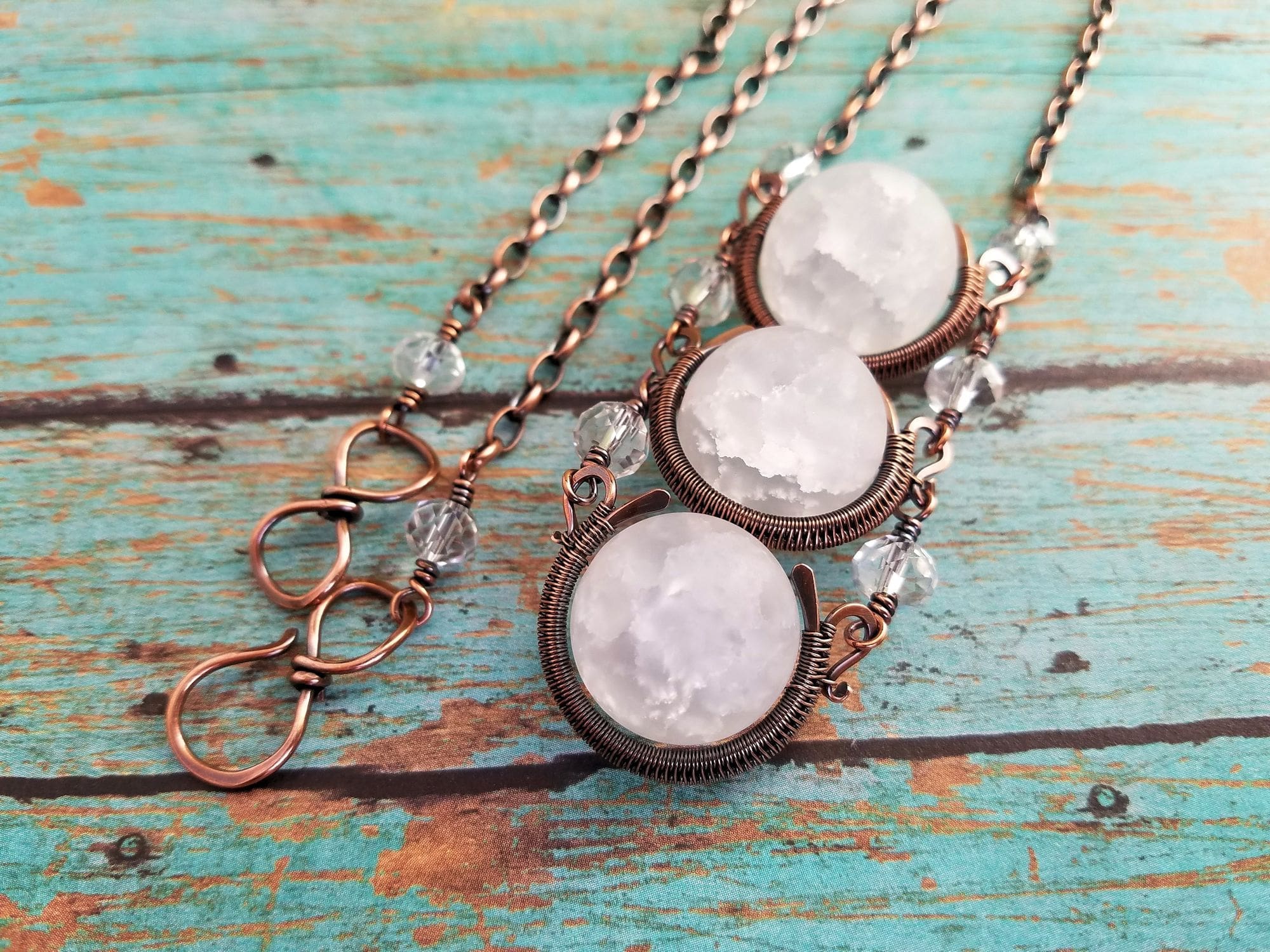
I don’t know about you, but I like jewelry projects that I can knock out quickly. Don’t get me wrong. I like to take on major projects now and again. This blog happens to be one of my more monumental projects, as a matter of fact. But when it comes to making jewelry, I enjoy playing with simple modular designs. So I can put them together in a multitude of ways. And the Chalice Necklace is one of those designs.
The Chalice bead frame was originally designed for a particular bib necklace that I’ve yet to create. I’ll get around to making that necklace someday because it’ll be a great follow-up to this tutorial. In the meantime, I’m going to show you how to take a simple woven wire element and repeat it. That repetition makes a fabulous statement necklace.
If you haven’t already tried the free tutorial for my Chalice Earrings, be sure to check it out. That way you can make a pair of earrings to match the gorgeous Chalice Necklace we’re about to create together!
Copyright & Disclosure
You’re welcome to make and sell products from this tutorial. The only condition is that you credit Door 44 Studios for the design and link back to this page.
When it comes to my written tutorials, however, I reserve exclusive rights to all images and written content that you find here on my blog. You may not reproduce or redistribute any portion of this tutorial in any way, shape, or form. Furthermore, you may not teach the designs contained within this tutorial without my written permission.
This copyright applies to the downloadable PDF version of this tutorial as well, and it’s included therein. You may share the free version of this tutorial only by linking directly to this page.
This post may contain affiliate links. If you click on a link and then make a purchase, I may earn a small commission (at no cost to you). As an Amazon Associate I earn from qualifying purchases. To learn more, please see my full disclaimer.
Want a printable version of this tutorial?
Getting Started
For best results, use solid jewelry wire for your core wires and dead soft wire for weaving. If you use a filled wire, be aware that the core wires are finished and hardened by hammering. Even light hammering can expose the base metal core in filled wires, and that can negatively affect your final finish. I don’t recommend plated or anodized craft wire for these earrings. Those coatings will be ruined with this construction process.
How to Choose the Right Jewelry Wire
Jewelry wire is a constant source of confusion for beginners. I remember those days well! If you’d like to learn how to choose the right jewelry wire for wire weaving, be sure to read this post. In it, I share everything you need to know about jewelry wire as you set out on your wire weaving journey.
Skill Level: Intermediate
This is a more challenging project that involves wire weaving. It can be achieved by someone who has some basic wirework skills.
This tutorial uses the Modified Soumak Weave for two core wires and a basic hammer technique. Be sure to review those tutorials if you’re not familiar with those skills. You should also be comfortable weaving pre-formed core wires for this tutorial.
Other skills required are making wrapped loop connectors and working in very tight spaces.
If you’re making your Chalice Necklace in silver, you’ll also need to be familiar with piercing your weave and securing focal beads to a bead frame. This free tutorial will walk you through the process of securely suspending your focal beads with sturdier sterling silver wire. Fine silver wire isn’t strong enough to carry the weight of most gemstone beads.
Finished Size
- WIDTH: about 1-1/4 inch (3.18 cm)
- LENGTH: about 3 inches (7.62 cm)
I added a 36-inch chain embellished with asymmetrical splashes of crystal rondels to the pendant I made while writing this tutorial. I’ve included instructions for making the same chain that’s shown here. But you can of course customize the chain to suit your personal style.
You can easily make your pendant either longer or shorter by adding additional beads to the connectors between the linked bead frames. You can also easily adjust the overall length of your necklace by changing the lengths of chain and/or the number of beaded links specified in the instructions. Embellished chains are a great way to add your own unique personality and style to your necklace, so feel free to experiment.

Tools & Materials
- 16ga wire – 14 3/4 inches
- 18ga wire – 10 1/4 inches
- 20ga wire – 60 inches
- 24ga wire (Optional) – 15 inches
- 28ga dead soft wire – 156 inches
- 20mm round beads – 3 each
- 6mm x 8mm crystal rondel beads – 20 each
- 3.8mm Oval Rolo Chain – 27 inches
- Wire Cutters
- Chain Nose Pliers
- Round Nose Pliers
- Nylon Jaw Pliers
- Needle File
- Nylon Mallet or Rawhide Mallet
- Chasing Hammer
- Bench Block
- Ring mandrel
- Ruler
- Fine Point Permanent Marker
- Bead caliper (optional)
- Sharp Beading Awl (optional)
- Sunshine® polishing cloths (optional). These are the polishing cloths that I use for dry polishing jewelry.
Instructions
These instructions assume that you’re using 20mm beads, as specified in the materials list. However, the bead frame can be easily adapted to larger or smaller beads. If you’re using a different sized bead, you’ll need to add or subtract roughly 1/4-inch of wire on each of the two core wires for every 2mm difference in bead size. For your weaving wire add or subtract four inches for every 2mm difference in bead size.
To determine the size to use on your ring mandrel, locate the point that is the same size as your bead. Then use that point to form your inner core wire. Add three sizes to your first ring size to locate the point where you need to form your outer core wire.
I provide more detailed resizing instructions, including a quick-reference table with the most common bead sizes, in the downloadable PDF version of this tutorial.
Make the Chalice Bead Frame
The bead frame is a relatively simple component to make. The beauty of this frame is that it can be easily repeated and joined in various ways to create larger statement pieces. In fact, that’s what we’re about to do.
If you’d like to practice making the bead frame before you attempt this necklace, make the Chalice Earrings, which use 14mm beads, first.
Form the Core Wires
Step 1
Measure and cut three 2 1/4-inch pieces of 16ga wire.
File the ends smooth and mark the center point on each piece of wire.
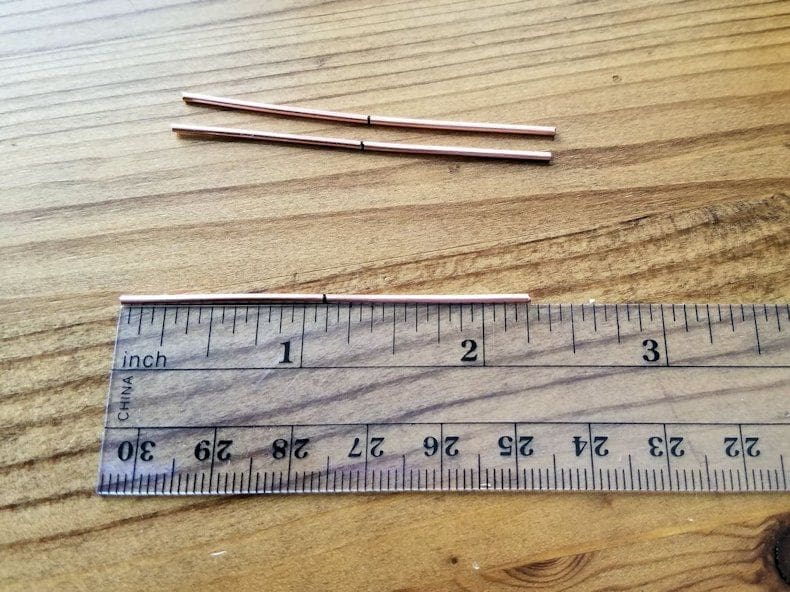
TIP: Accurate measurements make the difference between a good end result and a great end result. Take your time and double-check your measurements for best results.
Step 2
Place one piece of wire at the size 10 1/2 mark on your ring mandrel and gently form the wire around the mandrel. Use a rubber or rawhide mallet to form the ends so you have a continuous soft curve, as shown. Repeat for the remaining two wires.
These are your inner core wires, which will fit around your beads. Test the fit now. The curved wire should slip easily over your bead. The fit should be close, but not snug. If it feels snug, put the wire back on your mandrel and gently stretch it, 1/4 size at a time, until it slips easily over your bead.
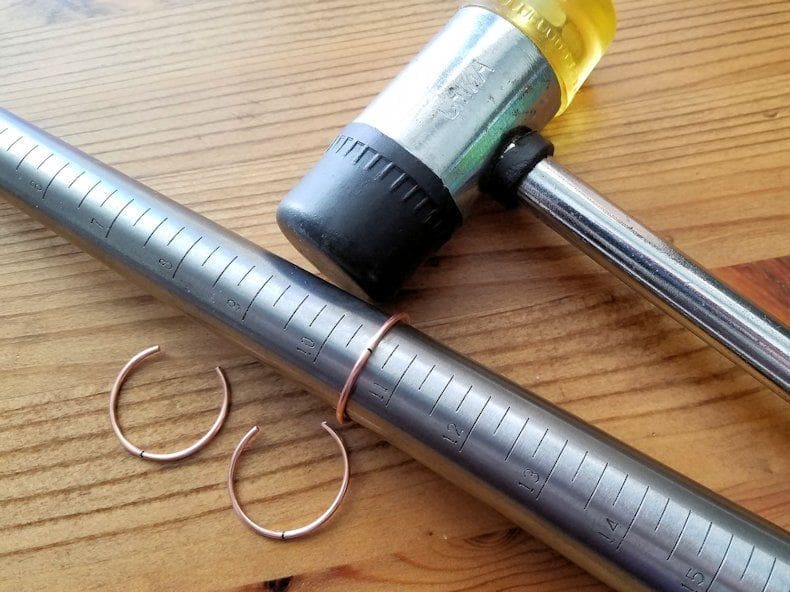
Step 3
Use your bench block and chasing hammer to paddle the ends of all three wires. You want just a slight paddle on about 1/4 inch of each end of the wire.
Smooth and shape the paddles with your needle file, if necessary, until your three core wires look like those shown.

Step 4
Take a straight piece of scrap wire (20ga works well for this step) and thread it though one of your beads.
Now center one of the 16ga core wires over the bead, as shown, and mark the locations of the hole of the bead on each side of the core wires.
Repeat for the remaining two 16ga core wires. You’ll use these marks to determine where you need to stop weaving the core wires in order to secure the bead before finishing off the weave.
Set the 16ga core wires aside for now.

Step 5
Measure and cut two 3 1/2-inch pieces and one 3 1/4-inch piece of 18ga half-hard wire.
File the ends smooth and mark each piece of wire at the center point with permanent marker.

Step 6
Use your bench block and chasing hammer to lightly paddle the tips of the 3 1/4-inch piece of 18ga wire. This will be for the bottom bead in the pendant cascade. Try not to hammer more than about 1/4 inch from each end, as shown.
Gently shape and smooth the paddled ends with your needle file.
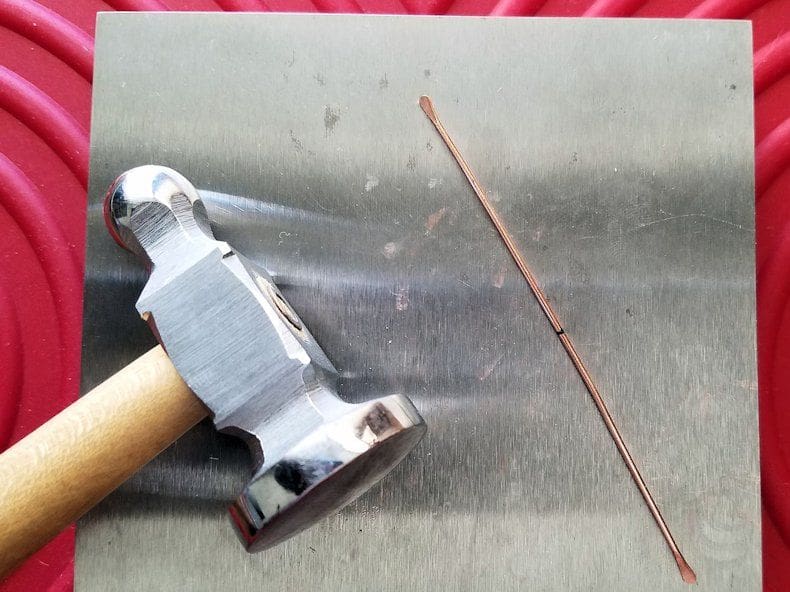
Step 7
Grasp the tip of one paddle with the very tips of your round nose pliers. Roll the paddle into a tight curl that wraps about 3/4 of the way around the tip of your pliers.
Repeat on the second paddle, making sure that the ends of the wire curl in toward each other, as shown.

Step 8
Take the same wire you just shaped in Step 7 and position one curled end of the wire at the center of your round nose pliers. Grasp the wire just under the tight curl you made in Step 7. The rounded face of the curl should be pointing toward you.
Use your fingers to push the long end of the wire away from you and bring it all the way around the tip of your round nose pliers until the small curl touches the straight length of the wire, as shown.
Repeat on the other end to complete your shape and set that wire aside for now.
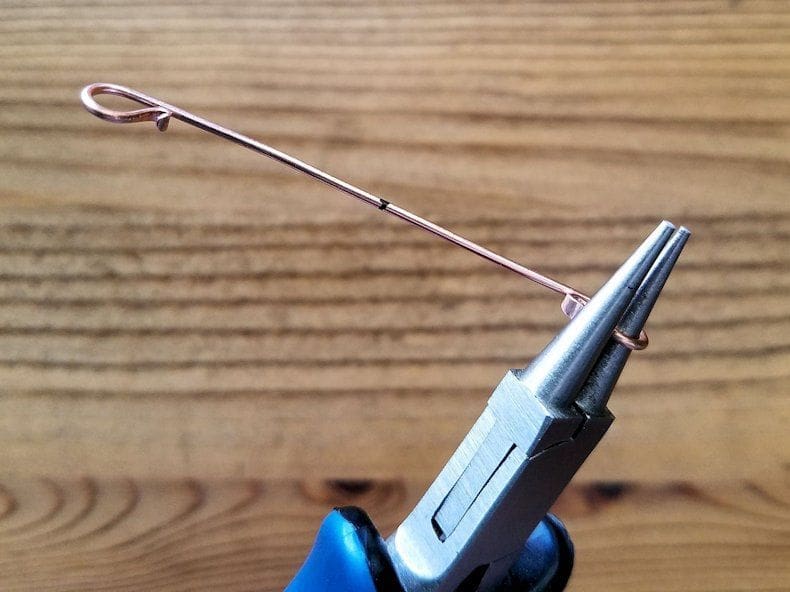
Step 9
We’ll now shape the remaining two core wires. These will be linked to other bead frames or to the necklace chain by both the large and small loops, so the small loops must be closed.
Grasp the tip of one 3 1/2-inch piece of 18ga wire with the tips of your round nose pliers. Roll the tip of the wire into a tight curl all the way around the nose of your pliers until the end of the wire touches the straight length of the wire.
Repeat on the other tip of the wire, making sure that both small loops curl in toward each other, as shown.
Repeat this step on the last piece of 18ga wire.
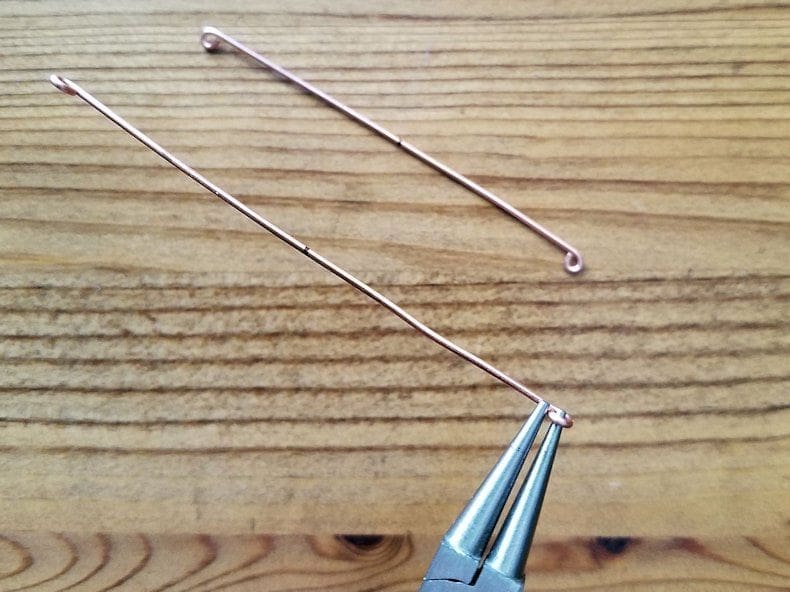
Step 10
Take one of the two wires you just formed in Step 9 and position one looped end of the wire at the center of your round nose pliers. Grasp the wire just under the small loop. The rounded face of the loop should be pointing toward you.
Use your fingers to push the long end of the wire away from you and bring it all the way around the barrel of your round nose pliers until the small loop touches the straight length of the wire, as shown.
Repeat on the other end to complete your shape and then repeat this entire step on your remaining 18ga wire.
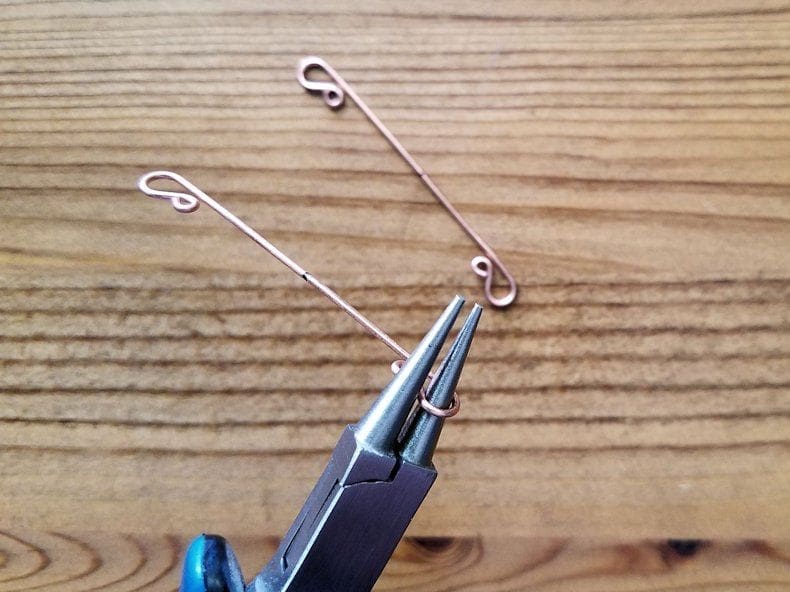
Step 11
Use your bench block and chasing hammer to flatten the loops of all three 18ga wires. Be careful not to flatten the open curls on the first piece your formed.
Hammering may open the gap between the straight portion of the wire and your small loops or curls. If so, gently squeeze the wires together with the tips of your round nose pliers. These ends will be lashed to the core wires in the next section of this tutorial, so don’t worry if there’s still a small gap between the curled or looped ends and the core wire.

Step 12
Position one 18ga piece of wire at the size 13 1/2 mark on your ring mandrel. Make sure the curled ends of the wire are facing up (away from the ring mandrel).
Gently form the 18ga wire into a continuous curve around the ring mandrel.
Repeat for the other two 18ga wires.
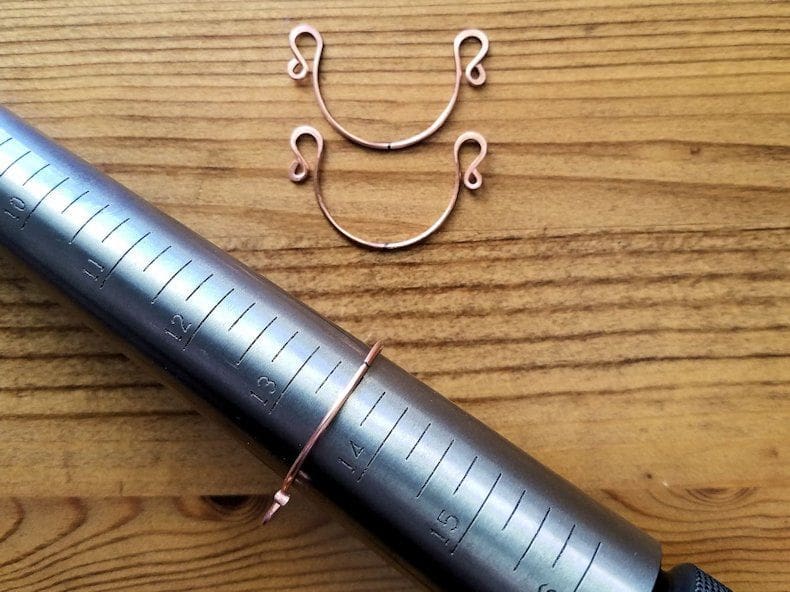
Your frame wires are now complete and ready to weave together. Before proceeding, nest the inner core wires (the 16ga wires) into the curve of the outer core wires (the 18ga wires) and line up the center marks.
The wires should nest closely together, and everything should be lined up symmetrically. If not, make any necessary adjustments now and mark new centerlines on your core wires.

Weave the Core Wires Together
Step 1
Cut three 52-inch lengths of dead soft 28ga wire.
Note: If you’re making your earrings with silver wire, you should have used half-hard sterling silver for the core wires prepared in the previous section. Use dead soft fine silver wire for weaving in this section.
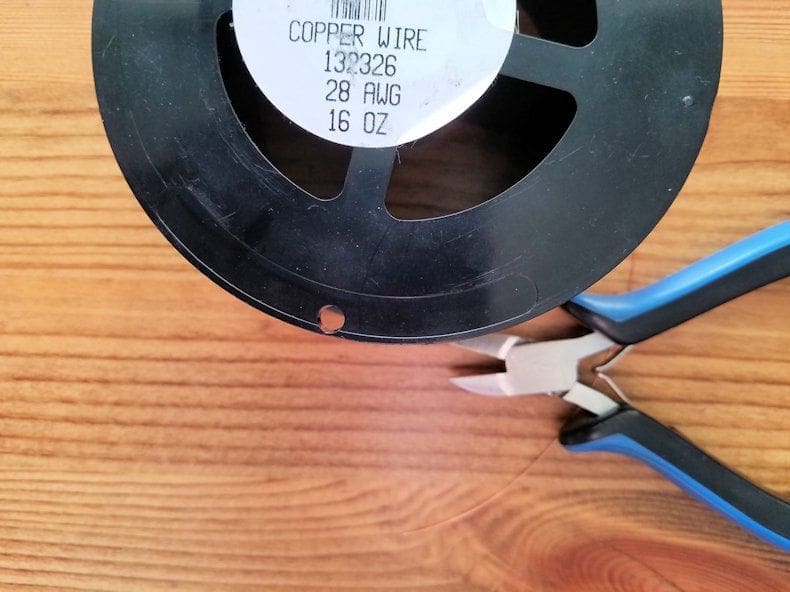
Step 2
Locate the center of your 52-inch weaving wire and position it at the center marks on your core wires. Begin weaving the two core wires together using the Modified Soumak weave.
Weave in one direction until you get to the mark you made in Step 4 of the previous section for your bead hole position. Stop just after making a single wrap around the inner core wire. Then flip the bead frame over and begin weaving in the other direction. Again, stop after making a single wrap around the inner core wire at the mark for your bead hole position.
Both wire tails should now be sticking out between the two core wires, one will be coming out the front of the frame, and the other will be coming out the back of the frame.
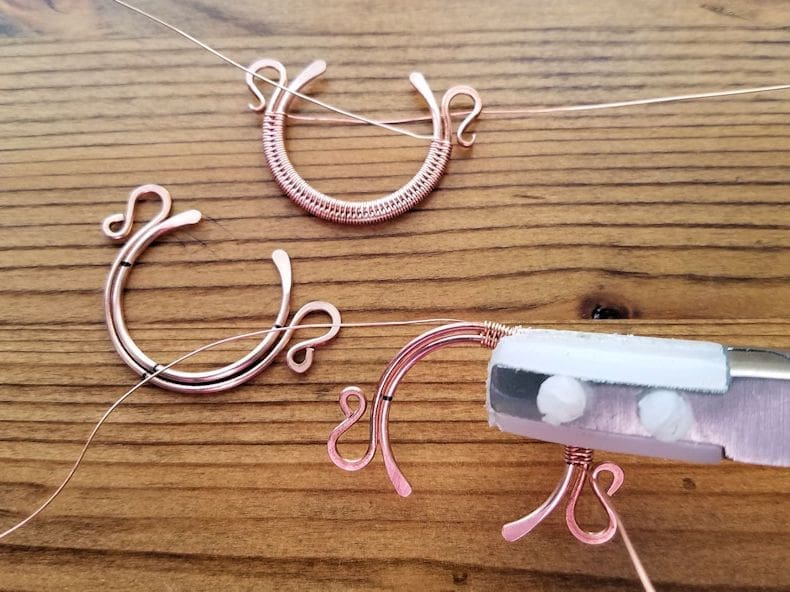
Step 3 (Optional)
Before securing the bead, I like to sculpt my bead frame to give it a little extra dimension. The modified Soumak weave allows the core wires to slide a bit, and I use this to my advantage in many of my designs.
Use your fingers to gently slide the inner core wire forward and the outer wire back. Then, using your fingers or your nylon jaw pliers, gently angle the curved loops toward the back, as shown. This sculpted curve is what gives your bead frames the distinctive look of a gilded chalice. You’ll really see this shape come alive when you weave your beads into the frames in the next step.
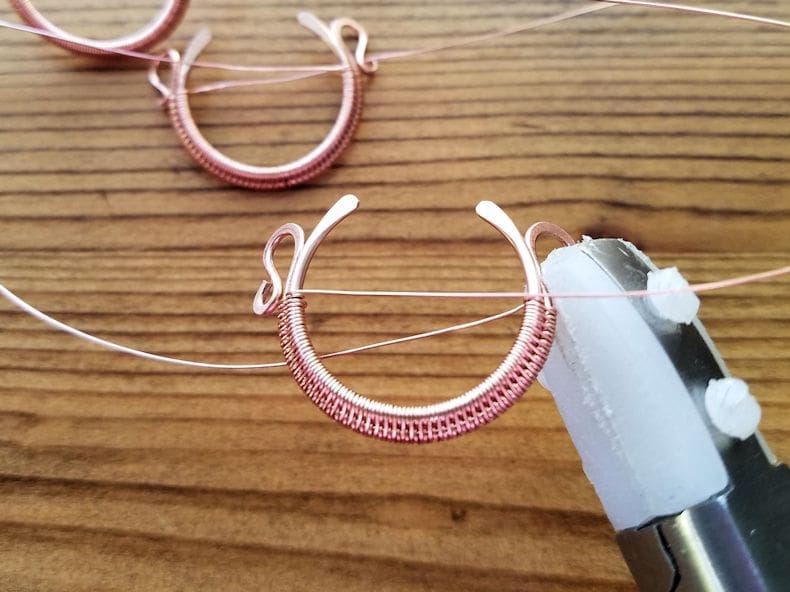
Step 4
If you’re making a silver pendant, skip this step and finish off the weave as instructed in Steps 5 and 6. Then pierce the weave on both sides of the frame at the points that align with the bead holes and secure your beads with 22ga half-hard sterling silver wire.
If you’re making a copper pendant, take the tail end of the weaving wire on the left side of the frame and thread it through the bead from left to right. Now take the tail of the weaving wire on the other side of the frame and thread it though the bead from right to left. Carefully tug on the wires and work your bead into the center of the frame. Make sure you pull the wires all the way through the bead so there are no kinks left on either side of the bead.
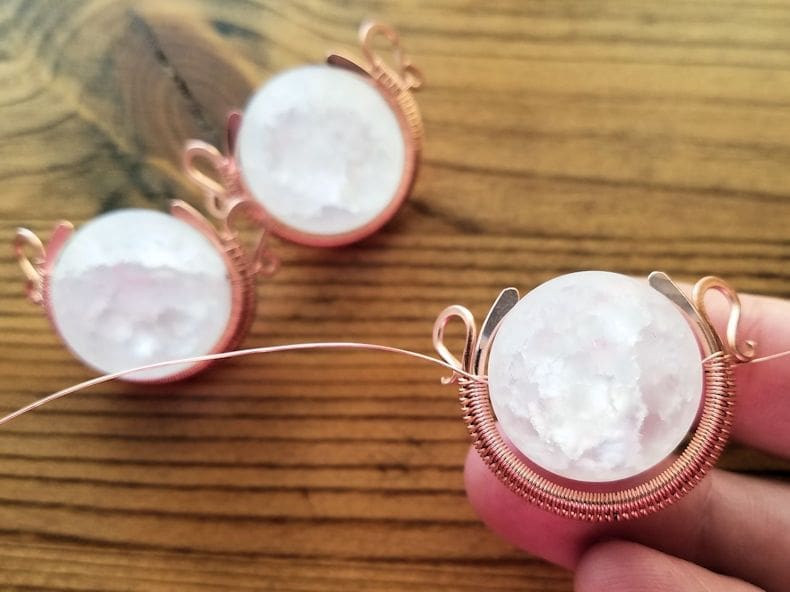
Step 5
Pick up the weave where you left off before threading your wires through the bead and continue until you reach the small loops or curls on the outer core wire.
Lash the formed ends in place by integrating that point into your weave as if it were a third core wire. Complete one pattern repeat around all three wires and then switch back to wrapping just the two inner wires for a few more pattern repeats.
Keep an eye on symmetry as you go and stop before you get too close to the end of the inner core wire.
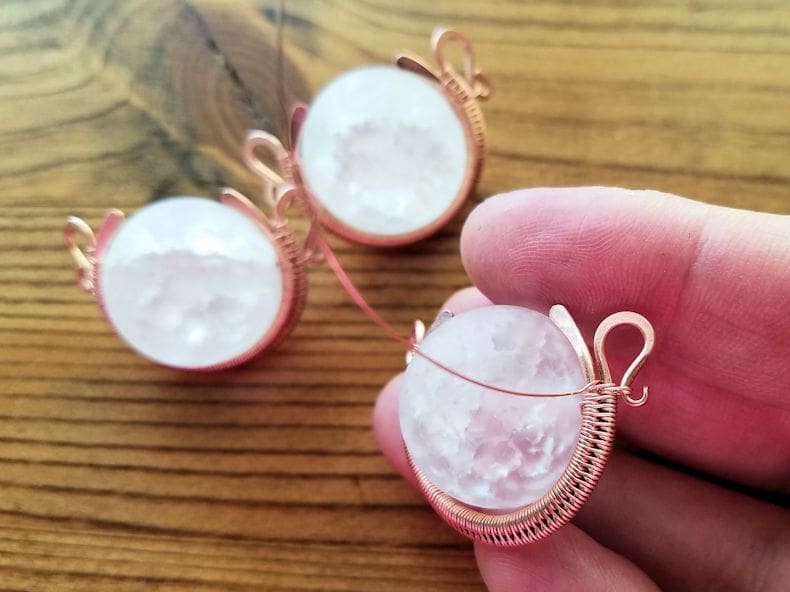
Step 6
To finish off the weave, wrap the wire three times around the outer core wire and break off your weaving wire. Repeat on the other side to secure that wire tail.
Repeat Steps 1 through 6 of this section for the other two bead frames if you haven’t already done so (I usually make mine at the same time so I can keep an eye on symmetry).
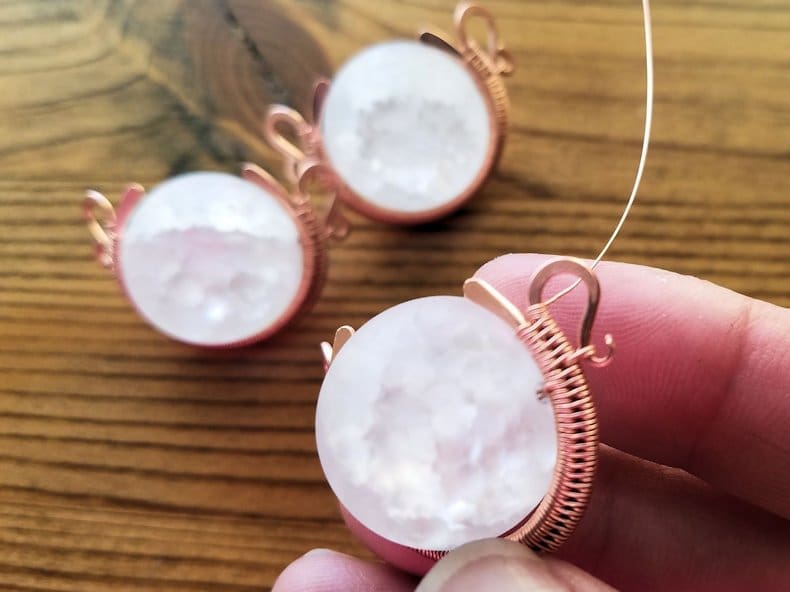
Assemble the Pendant
Step 1
Cut four pieces of 20ga half-hard wire 3 inches long.
Mark each wire at 1 1/4 inches from one end. This is where you’ll start your first wrapped loop.

Step 2
Make a complete wrapped loop on one end of each of the four pieces of 20ga wire you just cut and marked. These loops will be connected to the small loops you made on two of your wire woven bead frames.
TIP: When making the beaded connectors for the pendant, make sure both loops on each connector are oriented the same way so your focal beads will hang properly.

Step 3
Thread one 6mm x 8mm rondel onto a wrapped loop and begin the second wrapped loop on the other side of the bead. Thread that loop onto one of the large loops of your bottom framed bead (the one with the open curls) before closing the loop with the same number of wraps you used on the other end.
Repeat on the other side of the bead frame with another wrapped loop and rondel bead.
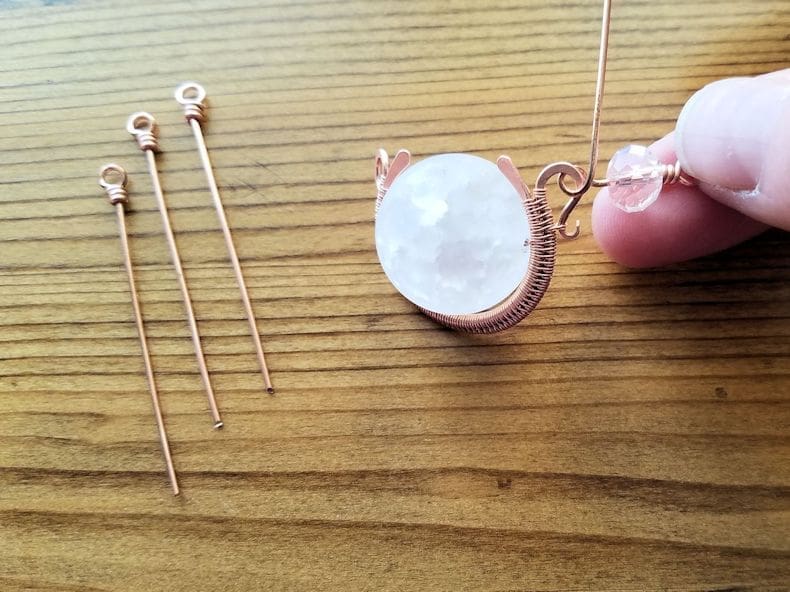
Step 4
Pick up another framed focal bead and, using your chain nose pliers, gently open the small loops on both sides of the frame.
Hook the closed loops of the connectors you just added to the first framed focal bead onto those small loops. Make sure you position them so they’re hanging straight and not twisted. Then close the small loops on the sides of your second framed focal bead.

Step 5
Repeat Steps 3 and 4 to attach the third framed focal bead to your pendant cascade.
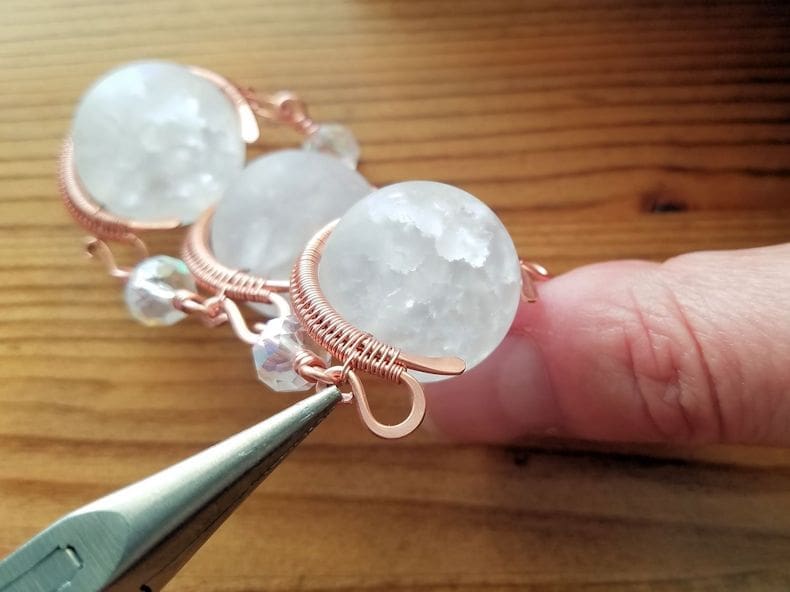
Your Chalice Pendant is now complete. You can finish it with a chain of your own choice now or continue on to the next section where I’ll walk you through the process of making the asymmetrical beaded chain I used on the Chalice Necklace I made while writing this tutorial.
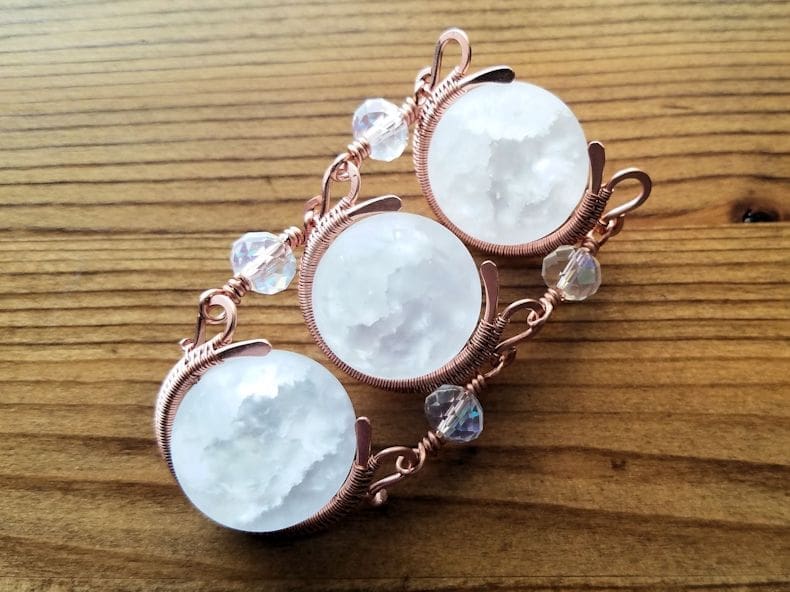
Assemble the Chain
Step 1
Cut a piece of chain that is 27 inches long (or 161 links, if you’re using the same chain that I used and you want to be precise).
We’re going to cut this chain into shorter sections and link them together with 3-bead sections of Rosary-style chain. You’ll need 80 links of chain for each half of the necklace.
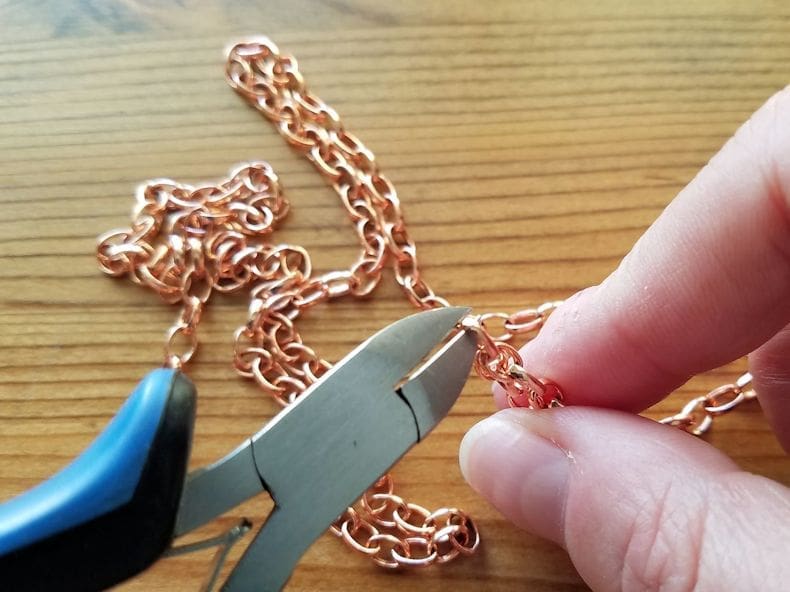
Step 2
Cut sixteen pieces of 20ga half-hard wire 3 inches long. Mark each wire at 1 1/4 inches from one end. You’ll begin your wrapped loops at that mark.
TIP: Be consistent when making wrapped loops. Try to keep the same number of wraps on both ends of all connectors that you make for a single piece of jewelry.

Step 3
Begin a wrapped loop and thread the loop through one of the large loops at the top of your pendant. Finish wrapping the loop.
Repeat on the other side of the frame. We’re now going to work on one half of the chain at a time.
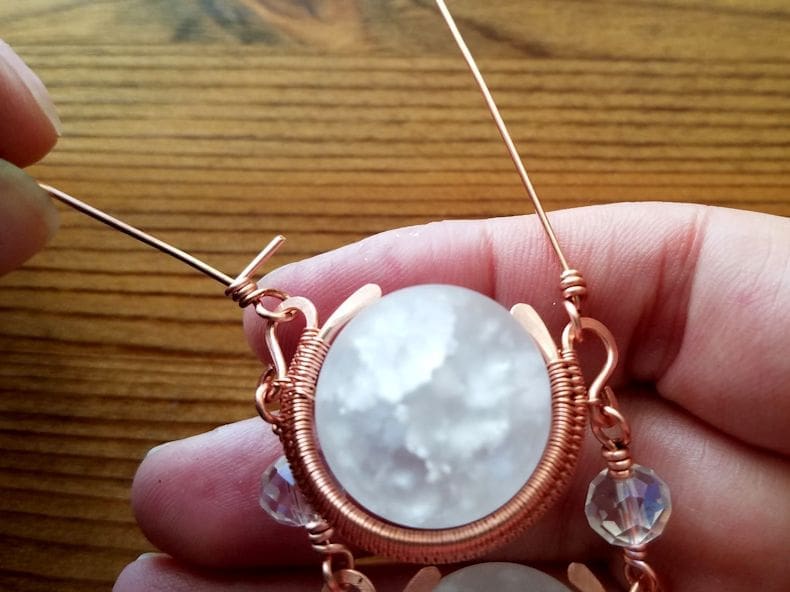
Step 4
Thread one 6mm x 8mm rondel bead on one of the wrapped loops you just added to the top of your Chalice Pendant.
Begin a second wrapped loop just above the bead and thread one end of your chain onto that loop. Close the loop with the same number of wraps you used on the other end of the beaded connector.
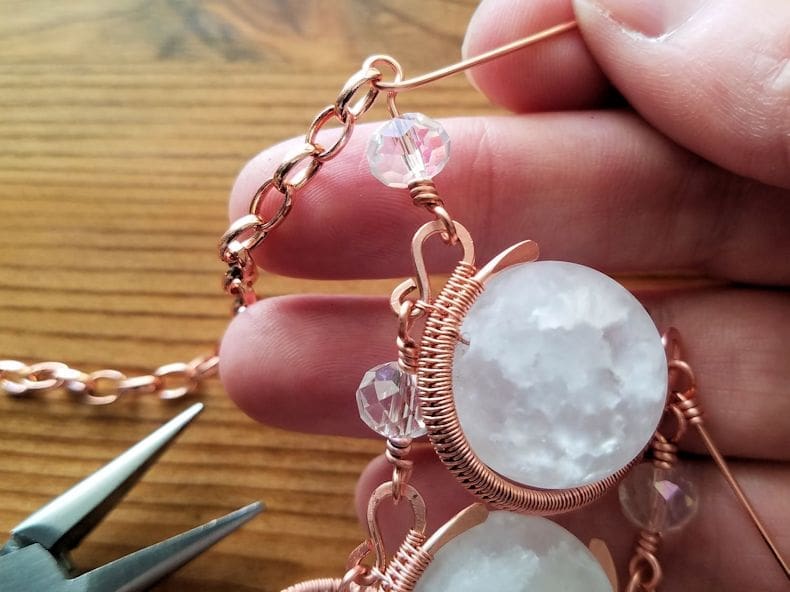
Step 5
The first section of chain is 15 links long, or about 2 1/2 inches if you’re using a different chain than the one specified.
Cut the chain to length and add three wrapped loop links using the 20ga wires you precut in Step 2 and three 6mm x 8mm rondel beads. Connect the end loop of the third beaded connector to your chain before completing the wraps.
TIP: When making beaded connectors for Rosary-style chain, alternate the direction of the loops on each side of the connector so they are perpendicular to one another. This helps minimize kinking of the chain.
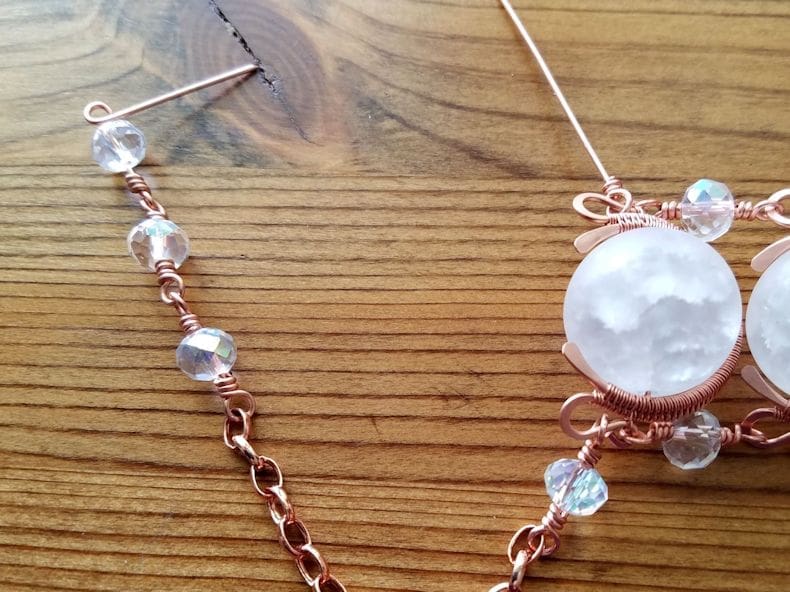
Step 6
The second section of chain is 20 links long, or about 3 3/8 inches if you’re using a different chain than the one specified in the materials list.
Cut the chain to length and add three wrapped loop links using the 20ga precut wires and three 6mm x 8mm rondels. Connect the end of the third wrapped loop to your chain before completing the wraps.
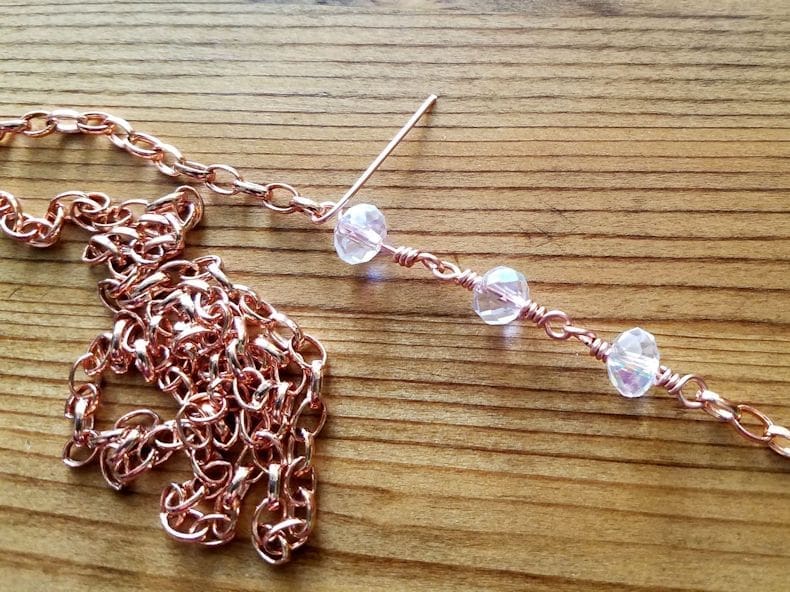
Step 7
The third section of chain is 43 links long. Or about 7 1/4 inches if you’re using a different chain than the one I used.
Cut the chain to length and connect one beaded wrapped loop to the end of the chain. Leave the other loop open. You’ll connect this end to your clasp.
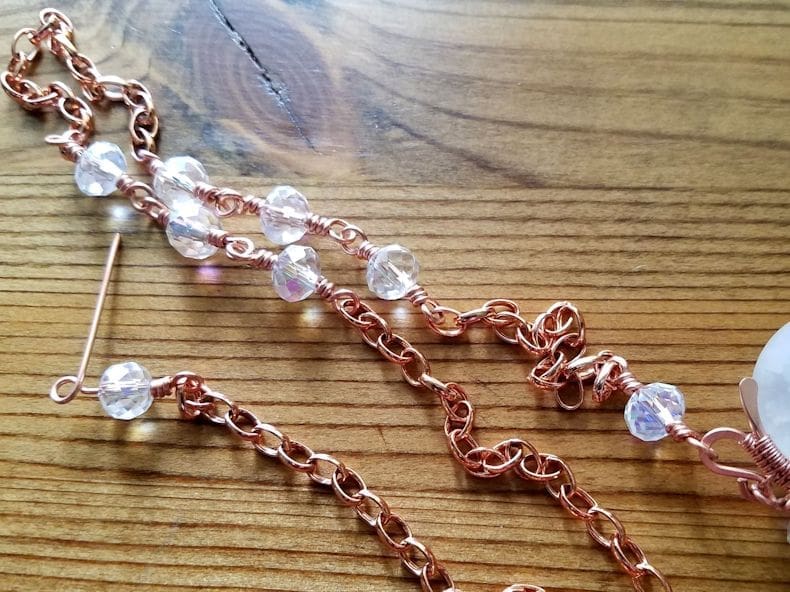
Step 8
Connect the remaining length of chain to the remaining wrapped loop you added to the top of your pendant in Step 3.
If you want your section of beaded links to be symmetrical, repeat Steps 5 through 7 on the other side of your pendant.
If you’re like me, though, and you like a little asymmetry to add interest to long sections of chain, proceed to Step 9.
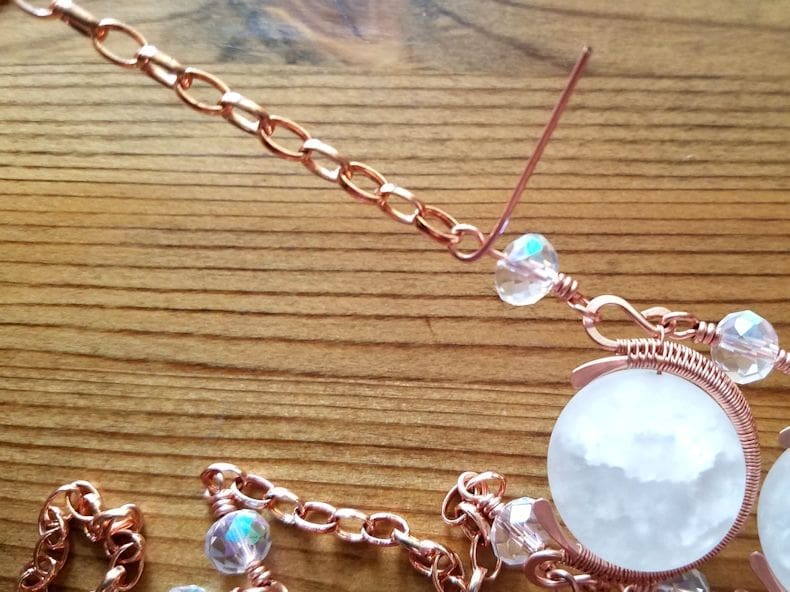
Step 9
The first asymmetrical length of chain is 30 links long or about 5 inches if you’re using a different chain.
Cut the chain to length. Then add three wrapped loop links using the 20ga precut wires and three 6mm x 8mm rondels. Connect the end of the third wrapped loop to your remaining section of chain. Then close your loop with the same number of wraps (I always use three wraps).
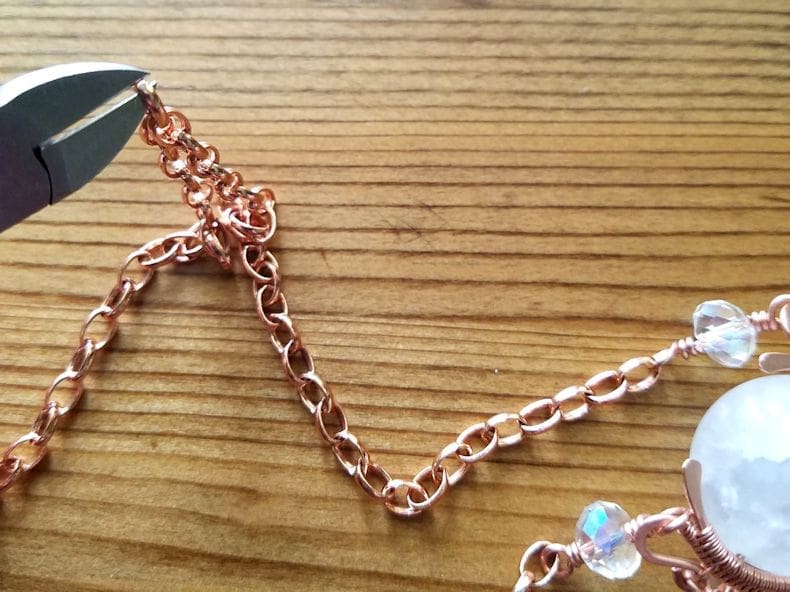
Step 10
The second asymmetrical length of chain is 20 links long. Or about 3 3/8 inches if you’re using a different chain.
Cut the chain to length and add three wrapped loops links using the 20ga precut wires and three 6mm x 8mm rondels. Connect the end of the third wrapped loop to your remaining section of chain before completing the wraps.
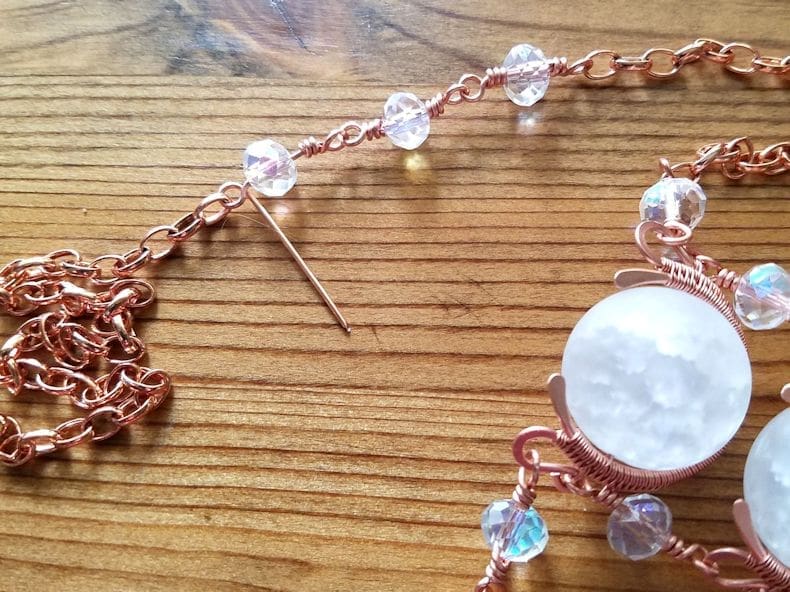
Step 11
Connect your final beaded connector to the end of your chain. Leave the top loop open so you can connect it to your clasp.
You can use a pre-made clasp to finish off your necklace now. Or, since this chain is long enough to slip over your head, you can connect the two sides of the necklace together with another beaded connector.
I prefer to use a clasp on long necklaces because it allows adjusting the length of the chain. And I always make my own clasps for necklaces because I love that extra little handcrafted detail.
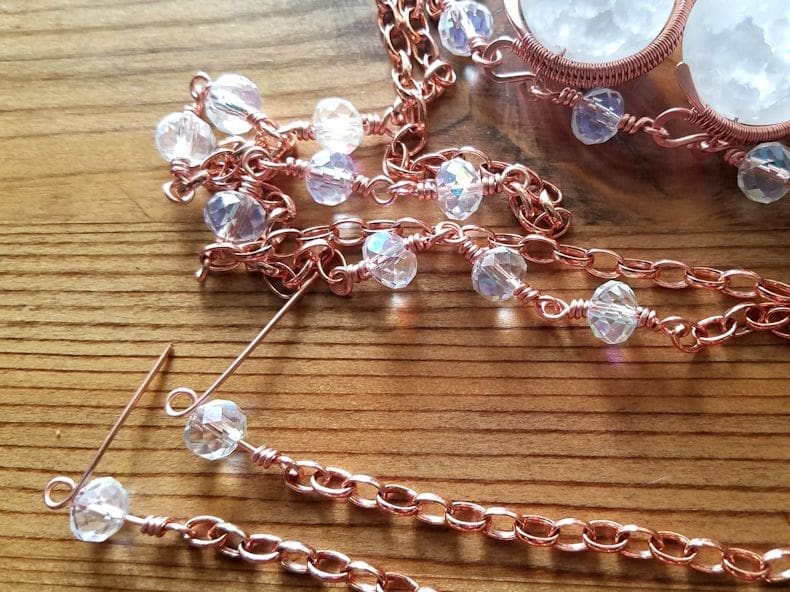
Step 12
Using 8 inches of 16ga half-hard wire, make a large Infinity Clasp. Connect one half of the clasp to each of your remaining open loops.
If you prefer to work from a printed copy, my easy Infinity Clasp is also available as a downloadable PDF.
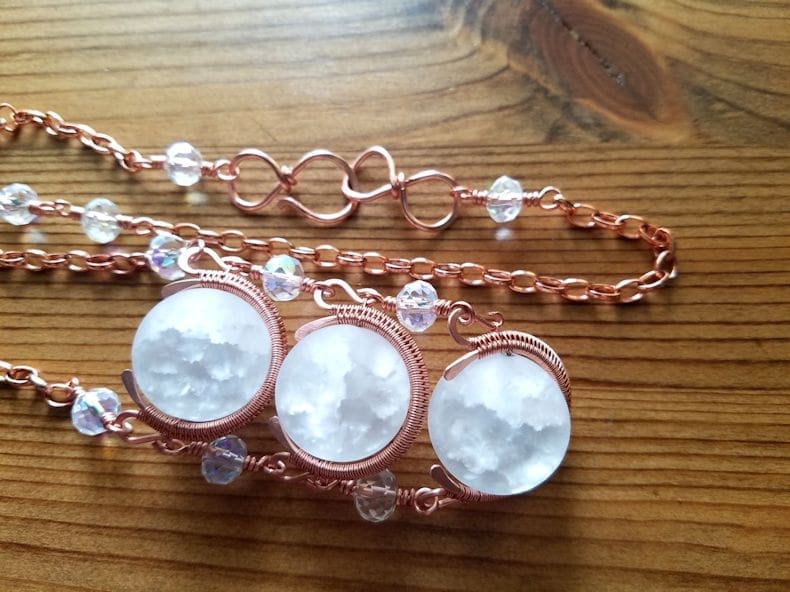
That’s it! Your Chalice Necklace is now complete and ready for its final finish.
Want a printable version of this tutorial?
Finishing Your Chalice Necklace
I antiqued the Chalice Necklace that I made while writing this tutorial with Liver of Sulfur (LOS). Then I burnished the patinated piece with super fine steel wool (Grade #0000) in a warm bath of water and original Blue Dawn dish soap. The steel wool brings back the bright copper highlights on the high spots.
Once that’s done, I rinsed my jewelry thoroughly to remove any particles of steel wool. Then I put the freshly washed piece in a tumbler barrel filled with warm water and a generous squirt of Blue Dawn. I tumble each barrel for a minimum of two hours.
Learn More About Finishing
If you’re nervous about finishing, be sure to read this detailed tutorial that walks you through my 7-step patina process. And if you’re wondering why I recommend tumble polishing specifically, check out this post as well. Finally, be sure to clean your stainless steel shot regularly. Clean shot is necessary to achieve the best finish on your tumble-polished jewelry.
One last bit of tumbler advice before you go. Always make sure that any beads or stones that you use for your jewelry are safe to tumble. I don’t recommend tumbling natural pearls, soft gemstones, ceramic beads, or glass beads with polymer coatings, such as glass pearls and certain frosted-look glass. If you’re not sure if your beads can handle the tumbler, run a test tumble with a bead that you’re willing to sacrifice.
Variations of the Chalice Necklace
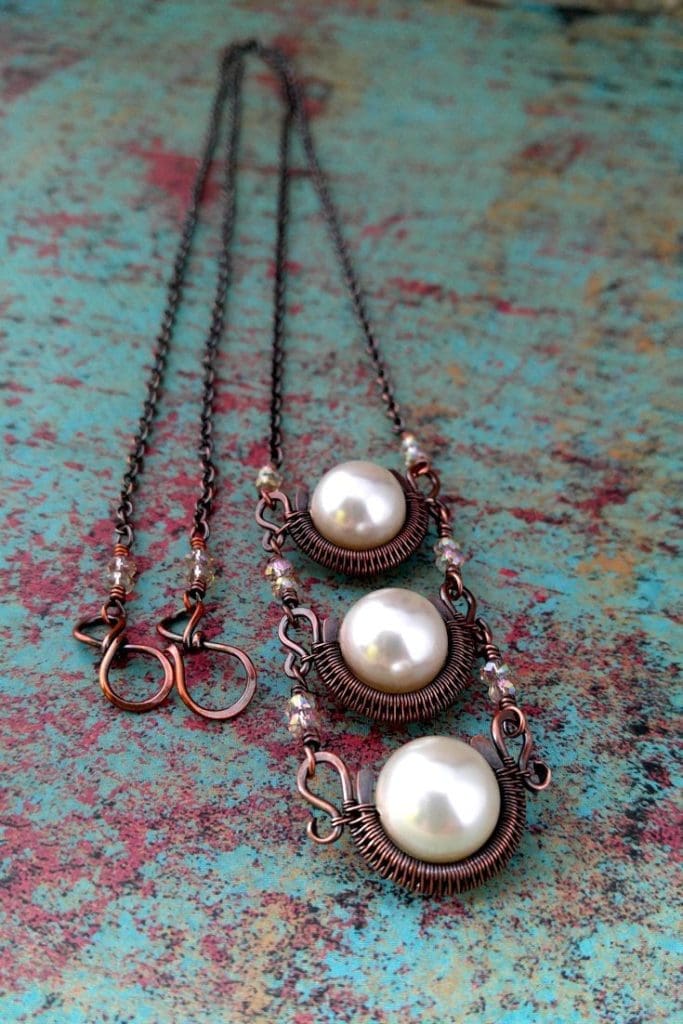
The Chalice Necklace design can be adapted to virtually any size round beads, including coin-style beads with center-side drilled holes. The necklace shown here is made with 12mm Swarovski Pearls. For beads smaller than 12mm, make 12mm bead frames. Then use spacer beads to fill the gap on either side of your focal bead.
You can also play with how you connect your framed focal beads. Try connecting them horizontally instead of vertically for an entirely different look. Or make a bold bib necklace by connecting several framed focal beads in a grid. The beauty of these simple wire woven bead frames is their modular nature. You can connect as few or as many as you like to create pieces that are uniquely your own.
I provide much more detailed information about resizing the bead frames in the downloadable PDF version of this tutorial. That tutorial (available exclusively in my Etsy shop) includes a handy reference table that lists the wire gauges and measurements for five common bead sizes,
Discover More Behind Door 44
Thanks so much for joining me today. I hope you enjoyed my Chalice Necklace tutorial. Would you like to make a pair of beautiful Chalice Earrings to match your fabulous new necklace? You’ll find the free version of that tutorial here. Or you can purchase a downloadable PDF version of the earring tutorial here.
Want more free wire jewelry goodness?
I like to share useful wire weaving tips and tricks on my social media channels, and we have some great conversations about wire jewelry in my private Facebook Group. Also, be sure to connect with me @door44studios on Instagram, and Facebook to keep up with everything that’s happening behind Door 44. And if you haven’t already done so, be sure to subscribe to my YouTube channel where you’ll find new wire jewelry videos weekly.
Until next time, go make something beautiful!




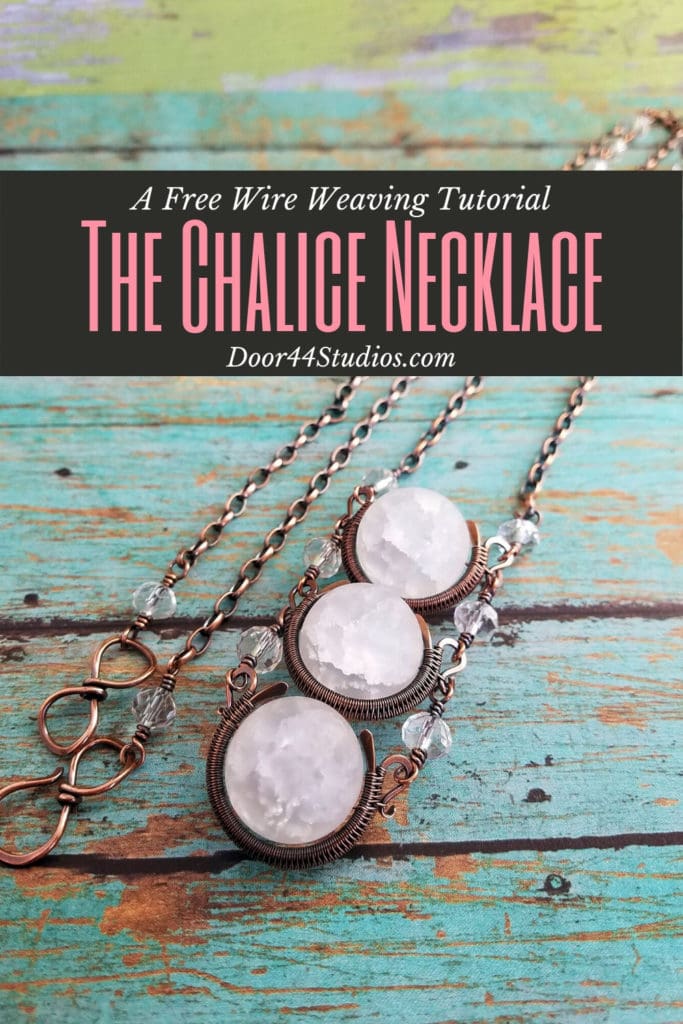
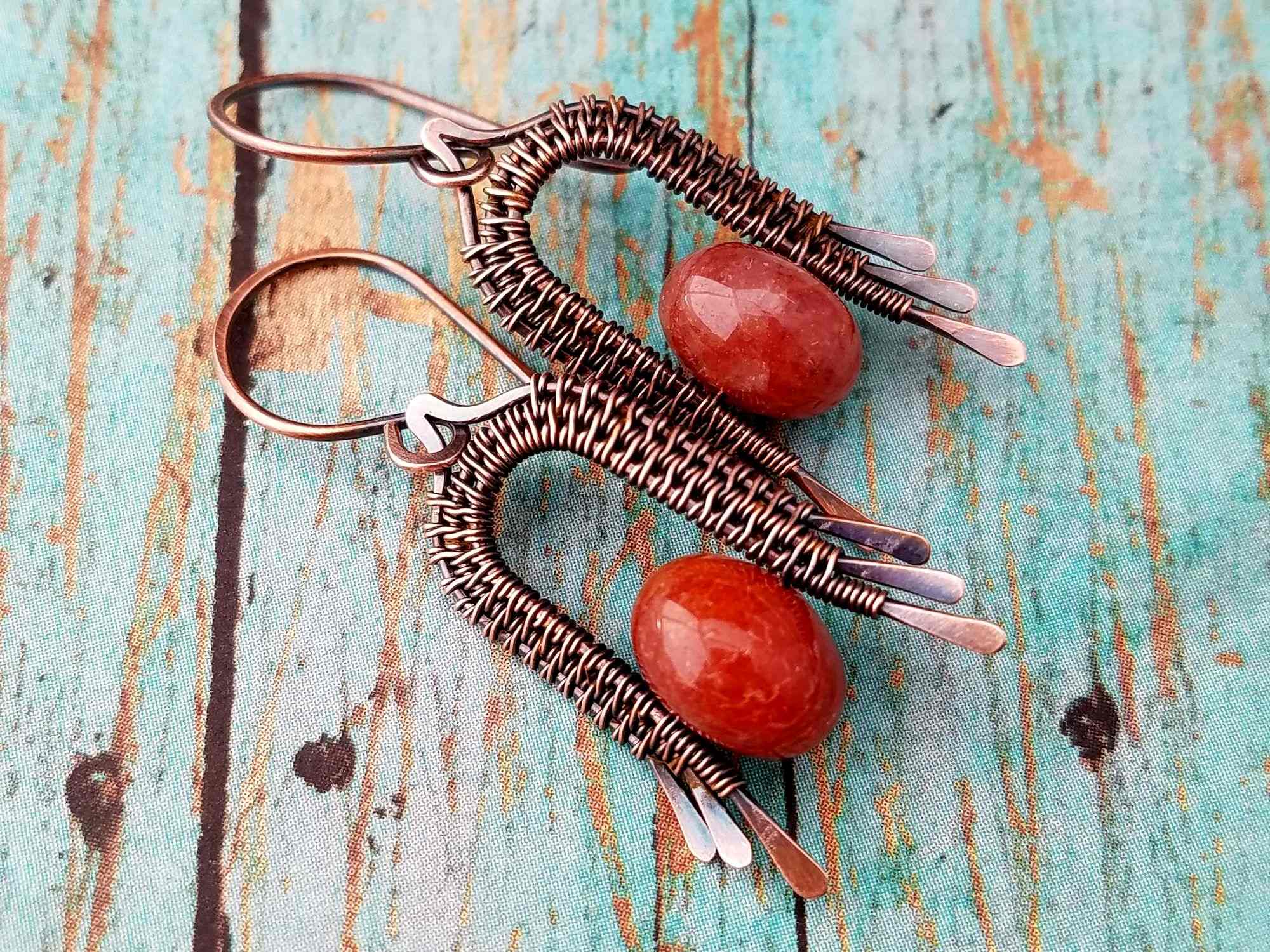

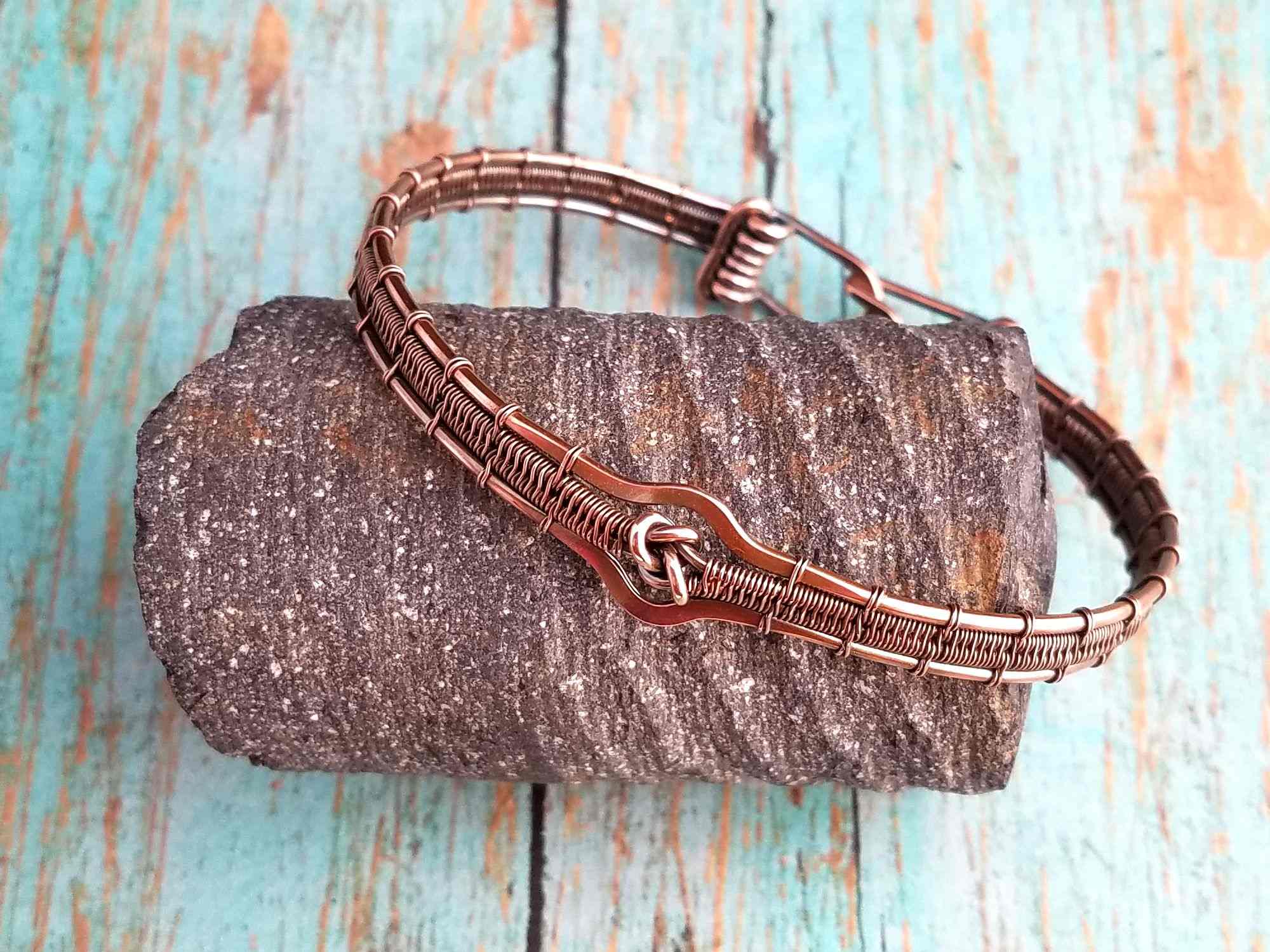

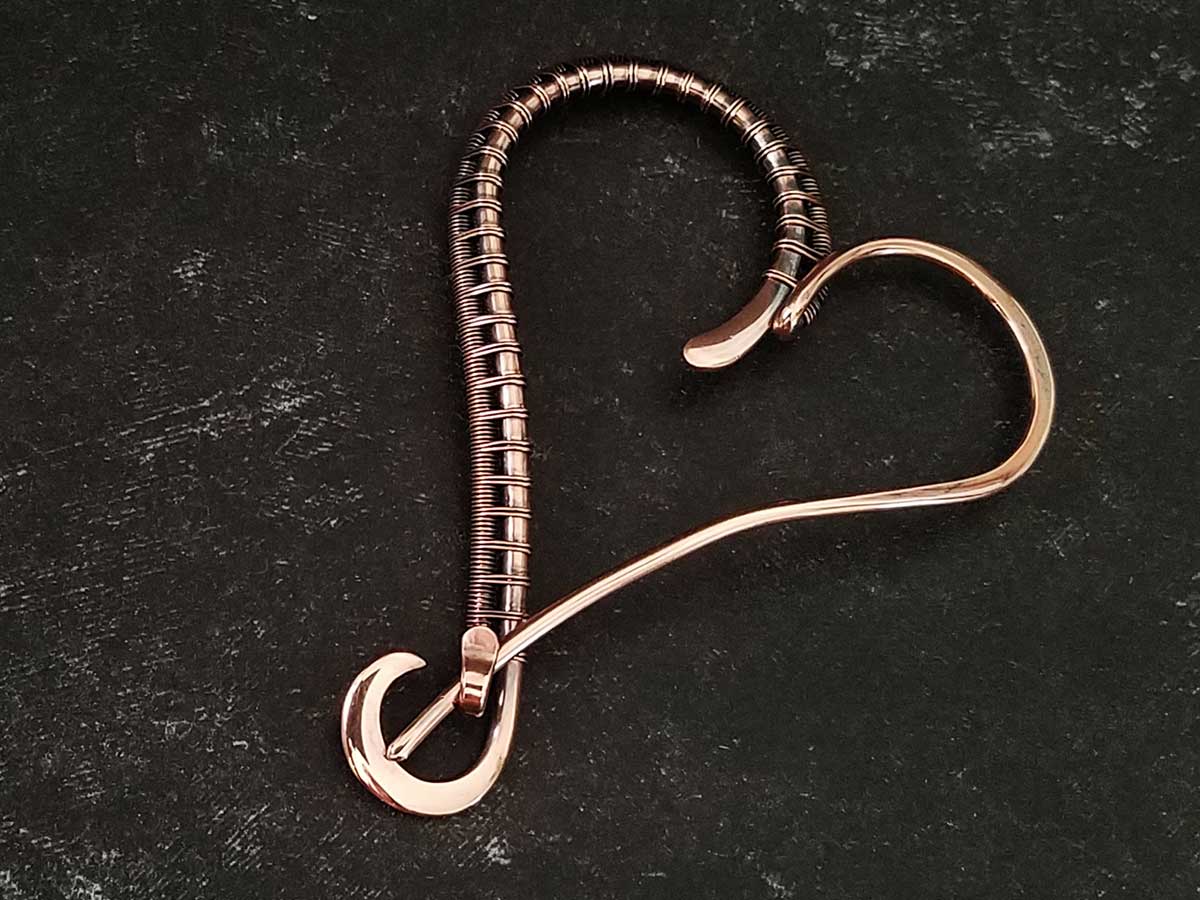
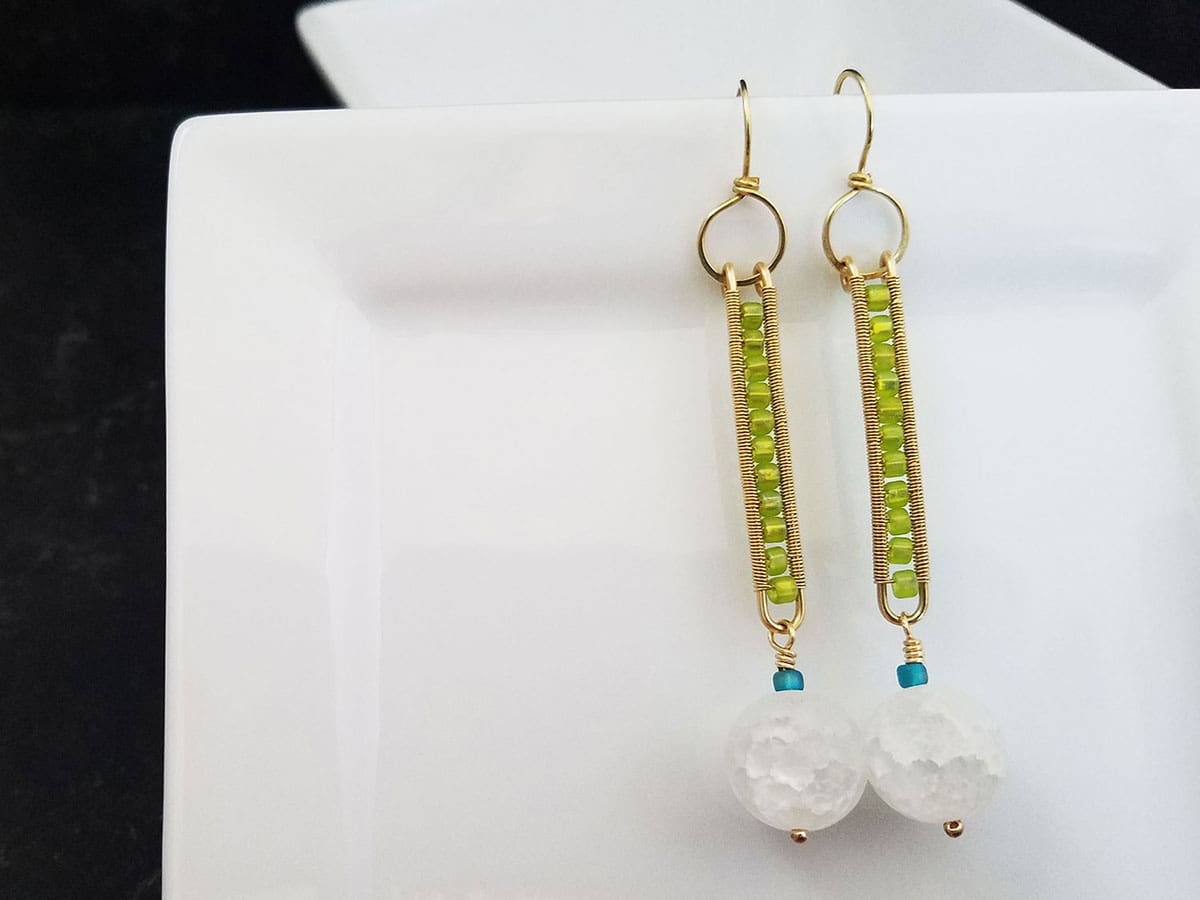
It’s absolutely gorgeous, love the design … makes me want to try my hand at wire weaving! Thank you for this tutorial!
Thank you, Julie. I’m so glad you love it! It’s a very achievable project for a beginner. You can do it, for sure!